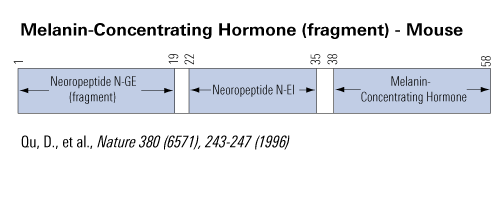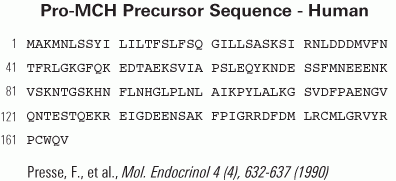


Melanin-concentrating hormone (MCH) is a cyclic neuropeptide, with a major role in stimulation of feeding behavior in mammals. MCH signals in the brain occur via two seven-transmembrane G protein-coupled receptors, namely MCH1 (SLC-1, MCH(1), MCH-R1, or MCH-1R) and MCH2 (SLT, MCH(2), MCH-R2, or MCH-2R). In this study, we demonstrate that the pro-MCH(131-165) peptide neuropeptide-glutamic acid-isoleucine (NEI)-MCH is more potent than MCH in stimulating feeding in the rat. Using rat MCH1-expressed human embryonic kidney 293 cells, we show that NEI-MCH exhibits 5-fold less affinity in a binding assay and 2-fold less potency in a cAMP assay than MCH. A similar 7- to 8-fold shift in potency was observed in a Ca(2+)(i) assay using rat MCH1 or human MCH2-transfected Chinese hamster ovary cell models. This demonstrates that NEI-MCH is not a better agonist than MCH at either of the MCH receptors. Then, we compared the proteolysis resistance of MCH and NEI-MCH to rat brain membrane homogenates and purified proteases. Kinetics of peptide degradation using brain extracts indicated a t(1/2) of 34.8 min for MCH and 78.5 min for NEI-MCH with a specific pattern of cleavage of MCH but not NEI-MCH by exo- and endo-proteases. Furthermore, MCH was found highly susceptible to degradation by aminopeptidase M and endopeptidase 24.11, whereas NEI-MCH was fully resistant to proteolysis by these enzymes. Therefore, our results strongly suggest that reduced susceptibility to proteases of NEI-MCH compared with MCH account for its enhanced activity in feeding behavior. NEI-MCH represents therefore the first MCH natural functional "superagonist" so far described.
Maulon-feraille L, Della zuana O, Suply T, et al. Appetite-boosting property of pro-melanin-concentrating hormone(131-165) (neuropeptide-glutamic acid-isoleucine) is associated with proteolytic resistance. J Pharmacol Exp Ther. 2002;302(2):766-73
Melanin-concentrating hormone (MCH) and alpha-melanocyte-stimulating hormone (alpha-MSH) are known to exhibit mostly functionally antagonistic, but in some cases agonistic activities, e.g., in pigment cells and in the brain. Neuropeptide E-I (NEI) displays functional MCH-antagonist and MSH-agonist activity in different behavioral paradigms; the role of neuropeptide G-E (NGE) is not known. This study addressed the question of possible molecular interactions between alpha-MSH, MCH and the MCH-precursor-derived peptides NEI and NGE at the level of the pigment cell MCH receptor subtype (MCH-Rpc) and the different melanocortin (MC) receptors. Radioreceptor assays using [125I]MCH, [125l]alpha-MSH and [125I]NEI as radioligands and bioassays were performed with MCI-R-positive and MC1-R-negative mouse B16 melanoma cells and with COS cells expressing the different MC receptors. The IC50s of alpha-MSH and NEI or NGE for [125I]MCH displacement from mouse MCH-Rpc were 80-fold and, respectively, >300-fold higher than that of MCH, and the IC50s for MCH and NEI or NGE for [125I]alpha-MSH displacement from mouse MC1-R were 50,000-fold and >200,000-fold higher than that of alpha-MSH. No high-affinity binding sites for NEI were detected on B16 melanoma cells and there was no significant displacement of [1251]alpha-MSH by MCH, NEI or NGE with MC3-R, MC4-R and MC5-R expressed in COS cells. At concentrations of 100 nM to 10 microM, however, MCH, NEI and NGE induced cAMP formation and melanin synthesis which could be blocked by agouti protein or inhibitors of adenylate cyclase or protein kinase A. This shows that mammalian MCH-precursor-derived peptides may mimic MSH signalling via MC1-R activation at relatively high, but physiologically still relevant concentrations, as e.g. found in autocrine/paracrine signalling mechanisms.
Hintermann E, Tanner H, Talke-messerer C, Schlumberger S, Zumsteg U, Eberle AN. Interaction of melanin-concentrating hormone (MCH), neuropeptide E-I (NEI), neuropeptide G-E (NGE), and alpha-MSH with melanocortin and MCH receptors on mouse B16 melanoma cells. J Recept Signal Transduct Res. 2001;21(1):93-116
Two groups have identified a 353 amino acid G-coupled orphan receptor as receptor for MCH: Chambers, J. et al., Nature 400, 261-265 (1999) and Saito, Y. et al., Nature 400, 265-269 (1999). We offer several rat SLC-1 receptor fragments for antibody production as well as MCH and related peptides for obesity research and other studies.
The physiological role of melanin-concentrating hormone (MCH) in mammals is still very elusive, but this peptide might participate in the central control of the hypothalamopituitary adrenal (HPA) axis during adaptation to stress. Cloning and sequencing of the rat MCH (rMCH) cDNA revealed the existence of additional peptides encoded into the MCH precursor. Among these peptides, neuropeptide (N) glutamic acid (E) isoleucine (I) amide (NEI) is co-processed and secreted with MCH in rat hypothalamus. In the present work we examined: (1) The pattern of rMCH mRNA expression during the light and dark conditions in the rat hypothalamus and (2) The effect of intracerebroventricular (ICV) injections of rMCH and NEI in the control of basal or ether stress-modified release of corticotropin (ACTH), prolactin (PRL) and growth hormone (GH) secretion in vivo in light-on and light-off conditions. Our data indicate that rMCH mRNA levels do not change during the light-on period, but increase after the onset of darkness. Either alone or co-administered, rMCH and NEI do not modify basal secretion of GH and PRL at any time tested nor do they alter ether stress-induced changes in these two hormonal secretions. At the end of the light on period corresponding to the peak of the circadian rhythm in ACTH, administration of rMCH but not NEI leads to a decrease in ACTH levels while MCH is not effective during the light off period of the cycle (i.e. when basal ACTH levels are already low). Using a moderate ether induced stress, ACTH levels are only stimulated during the dark phase of the cycle.
Bluet-pajot MT, Presse F, Voko Z, et al. Neuropeptide-E-I antagonizes the action of melanin-concentrating hormone on stress-induced release of adrenocorticotropin in the rat. J Neuroendocrinol. 1995;7(4):297-303
Social Network Confirmation